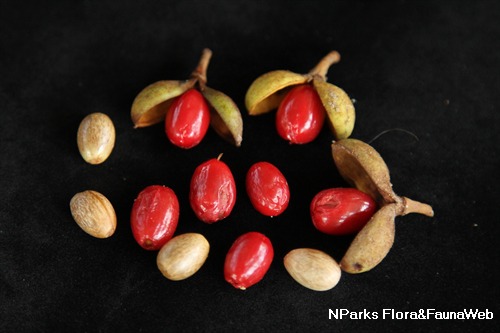
Back
Knema hookeriana (Wall. ex Hook.f. & Thomson) Warb.
| Family Name: | Myristicaceae |
| Common Name: | Great Woolly Nutmeg, Acu, Mendarah Rengas, Mendarah Penarahan, Daun Besar |
Name
Classifications and Characteristics
| Plant Division | Angiosperms (Flowering Seed Plants) (Dicotyledon) |
|---|---|
| Plant Growth Form | Tree |
| Lifespan (in Singapore) | Perennial |
| Mode of Nutrition | Autotrophic |
| Plant Shape | Conical |
| Maximum Height | 31 m |
Biogeography
| Native Distribution | Thailand, Sumatra, Malaysia, Singapore, and Borneo |
|---|---|
| Native Habitat | Terrestrial (Primary Rainforest, Secondary Rainforest) |
| Preferred Climate Zone | Tropical, Sub-Tropical / Monsoonal |
| Local Conservation Status | Native to Singapore (Critically Endangered (CR)) |
Description and Ethnobotany
| Growth Form | It is a tree up to 31 m tall, with a narrow, conical crown, and flaky bark. Its twigs, leaf stalks, flowers, and fruits are densely covered with yellowish-brown wool. |
|---|---|
| Foliage | Its alternate, stalked leaves possess leathery leaf blades that are lance-shaped, and 25–76 by 5–22 cm, with narrow, heart-shaped bases. Its young leaf blades are also covered with shaggy wool that drops off with age. |
| Flowers | The species is dioecious in which each individual tree only produces either only male or female flowers only. Its stalkless, flowering cluster (inflorescence) is up to 20 mm wide. The male flowering cluster consists of up to 20 male flowers, while the female cluster consists of up to 10 female flowers. Both male and female flowers are densely covered with woolly hairs. |
| Fruit | Its fruits are egg-shaped, 4.5–8 by 3–4.5 cm, and found in clusters of 1–3, with thick, yellowish-brown wool. Its seed has a bright red, fleshy covering (aril). |
| Habitat | It grows in primary and degraded forests on the top of ridges, and hillsides, from lowland to 800 m altitude. |
| Associated Fauna | Its flowers are insect-pollinated while its fruits are dispersed by birds. |
| Cultivation | It can be propagated by seed. |
| Etymology | Greek kneme, knee or internode; Latin hookeriana, named after Sir William J. Hooker (1785–1865), English botanist, and director of Kew Gardens (1841–1865) |
| Ethnobotanical Uses | Timber & Products: The fairly durable wood is used to construct roof-supports or houses. |
Landscaping Features
| Landscaping | It is suitable for planting in parks and streetscapes. |
|---|---|
| Desirable Plant Features | Ornamental Foliage |
| Landscape Uses | General, Suitable for Roadsides, Parks & Gardens, Small Gardens |
Fauna, Pollination and Dispersal
| Fauna Pollination Dispersal Associated Fauna | Bird-Attracting (Fruits, Associated with: Anthracoceros albirostris) |
|---|---|
| Pollination Method(s) | Biotic (Fauna) |
| Seed or Spore Dispersal | Biotic (Fauna) |
Plant Care and Propagation
| Light Preference | Full Sun, Semi-Shade |
|---|---|
| Water Preference | Moderate Water |
| Plant Growth Rate | Moderate |
| Rootzone Tolerance | Moist Soils, Well-Drained Soils, Fertile Loamy Soils |
| Maintenance Requirements | Moderate |
| Propagation Method | Seed |
Foliar
| Foliage Retention | Evergreen |
|---|---|
| Mature Foliage Colour(s) | Green |
| Mature Foliage Texture(s) | Velvety / Furry / Tomentose, Leathery |
| Young Flush Texture(s) | Velvety / Furry / Tomentose |
| Foliar Type | Simple / Unifoliate |
| Foliar Arrangement Along Stem | Alternate |
| Foliar Attachment to Stem | Petiolate |
| Foliar Shape(s) | Non-Palm Foliage (Lanceolate) |
| Foliar Venation | Pinnate / Net |
| Foliar Margin | Entire |
| Foliar Base | Cordate |
Floral (Angiosperm)
| Flower & Plant Sexuality | Unisexual Flowers , Dioecious |
| Flower Texture(s) | Velvety / Furry / Tomentose |
|---|
| Flower Grouping | Cluster / Inflorescence |
| Flower Location | Axillary |
| Flower Symmetry | Radial |
Fruit, Seed and Spore
| Mature Fruit Colour(s) | Brown, Yellow / Golden |
|---|---|
| Mature Fruit Texture(s) | Velvety / Furry / Tomentose |
| Fruit Classification | Simple Fruit |
| Fruit Type |
Image Repository
Others
| Master ID | 30045 |
|---|---|
| Species ID | 4354 |
| Flora Disclaimer | The information in this website has been compiled from reliable sources, such as reference works on medicinal plants. It is not a substitute for medical advice or treatment and NParks does not purport to provide any medical advice. Readers should always consult his/her physician before using or consuming a plant for medicinal purposes. |

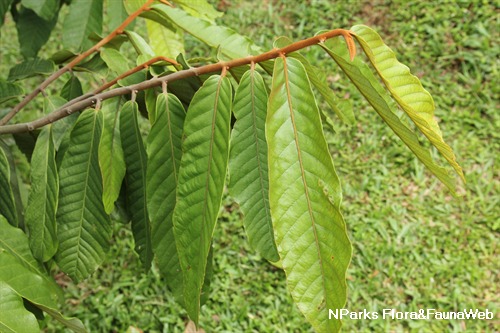
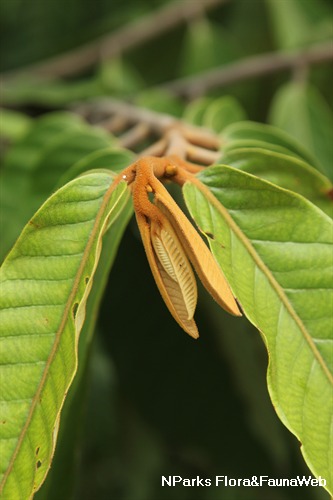
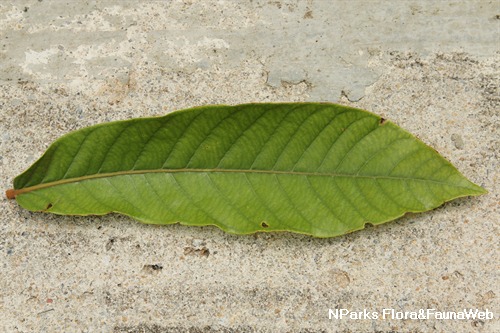

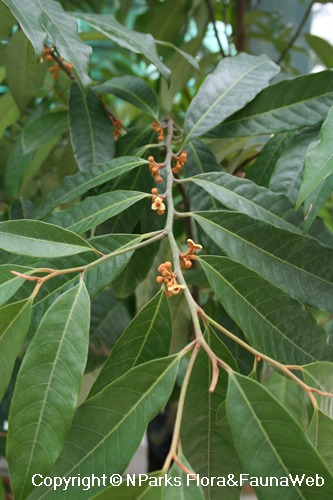

.jpg)
